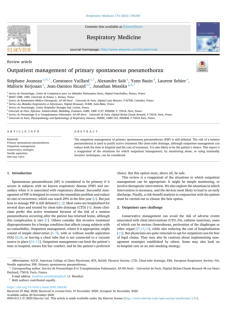First aid 1990 - 2021

Council directive 92/29/EEC of 31 March 1992 on the
minimum safety and health requirements for improved
medical treatment on board vessels



Author: J. Delosa
This paper reviews the problems in performing correct
volumetric or manometric mechanical ventilation inside
the chamber, blood transfusions and/ or administration of
vasoactive substances, control and surveillance of
infectious diseases and coordination between the surgical
and anaesthesiological procedures the patient may
require as often happens in patients with gas gangrene.
Problems concerning the medical and nursing staff are
also discussed, since these persons are often obliged to
stay under pressure.

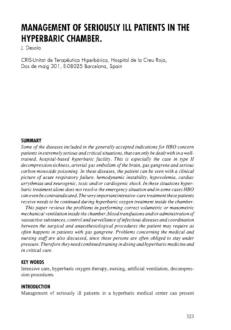

Author: Unknown
This document is a presentation of Cardiopulmonary
resuscitation (CPR) and most 1st aid techniques that can
be used to initiate personnel not familliar with such
procedures.



Author: Jacek Kot
All medical devices introduced into the hyperbaric
chamber should be of an appropriate design and fit for
use in the hyperbaric environment and the manufacturer
should certify them for hyperbaric conditions. However,
until now only several medical devices are CE marked for
usage in hyperbaric chambers. Therefore users often need
to perform themselves checking of the medical equipment
needed for continuation of intensive care during
hyperbaric treatment. To make this task easier, this paper
presents review of reports of usage of medical devices
under increased pressure.

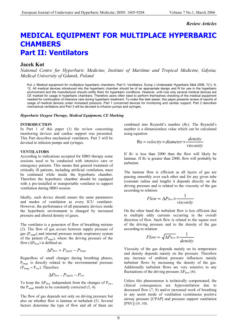

The International Labour Organization (ILO) Maritime
Labour Convention 2006 stipulates that all ships shall carry
a medicine chest, medical equipment and a medical
guide.
The International Medical Guide for Ships supports a main
principle of that Convention: to ensure that seafarers are
given health protection and medical care as comparable
as possible to that which is generally available to workers
ashore, including prompt access to the necessary
medicines, medical equipment and facilities for diagnosis
and treatment and to medical information and expertise.
Also consider the additional document Quantification
Addendum: International Medical Guide for Ships



Authors:
Martin A Croce, Louis J Magnotti, Stephanie A Savage,
George W Wood, Timothy C Fabian
An alternative to embolization or external pelvic fixation
(EPF) in patients with multiple pelvic fractures and
hemorrhage is a pelvic orthotic device (POD), which may
easily be placed in the resuscitation area. Little published
information is available about its effectiveness. This study
evaluated the efficacy of the POD compared with EPF in
patients with life-threatening pelvic fractures.



Author: John Penzo & Kirk Dobrowolski
This document provides comprehensive explanations
regarding drugs and their usage..

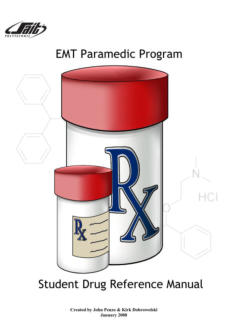

Author:
Schlaich C., Reinke A., Sevenich C., Riemer T., Oldenburg
M., 5 , Baur X., Horneland A., Jaremin BM., Nielsen.,
Wichtmann EM., Ioannidis., Brandal., Puskeppeleit M,
Denisenko I, Carter T, Nikolic N
This document has been published to help the non-
medical person in charge of medical care on board vessels
to make the best use of the medical chest and equipment
on board.



This document is the complement of the International
Medical Guide for Ships.
The University of Newcastle WHO Collaborating Centre
for Training in Pharmaco-economics and Rational
Pharmacotherapy was commissioned to develop a list of
recommended quantities of medicines listed in the third
edition of the International Medical Guide for Ships.



Authors:
M. Beuran, S. Paun, B. Gaspar, M. Vartic, S. Hostiuc, A.
Chiotoroiu, I. Negoi
There are many controversies related to the trauma
patient care during the pre-hospital period nowadays.
Due to the heterogeneity of the rescue personnel and
variability of protocols used in various countries, the
benefit of the pre-hospital advanced life support on
morbidity and mortality has been not established.
The authors reviewed the literature in what concerns the
basic and advanced life support given to the trauma
patients during the pre-hospital period.



This user manual relates to the DanMedical Analysis System
(D-MAS).
This manual explains how to set up and use D-MAS and
includes important safety information.
All information in this manual is based on D-MAS and the
standard factory default configuration.



This document is also availaible on DMAC’s website
Note that today defibrillators should be provided in all
chambers.

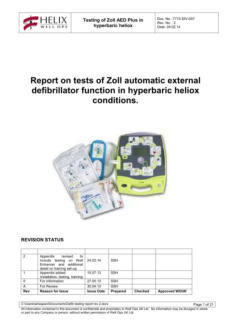

Author: Dr. Alan Moloff
This document, published by PYNG, a medical
equipement manufacturer, promotes the use of Pelvic
Stabilization devices.
Note that the mortality for pelvic fractures is very high due
to the major hemorrhage that can occur secondary to
pelvic fracture





This document is the method of use of the EZ-IO® Power
Driver, a sealed, hand-held, lithium battery powered
medical device for use with the EZ-IO® Intraosseous
Vascular Access System from Teleflex
(https://www.teleflex.com/usa/en/index.html).
This system can be used in any situation where
intravenous access is difficult to obtain in emergent,
urgent, or medically necessary cases. It is also described in
logistics/Mediical equipment


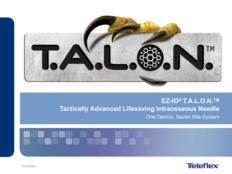

This document is a presentation published by PYNG
medical on the use of Pelvic Stabilization Devices.

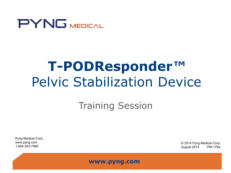

Authors:
Emmanuel Cauchy, MD, Sandra Leal, MD, Marie-Anne
Magnan, MD, and Hugo Nespoulet, Ph
A hyperbaric chamber is available in most trekking and
high-altitude expeditions primarily to treat and prevent
altitude illness. The device reproduces a low-altitude
evacuation when descent is impossible (Bartsch et al.,
1993). Atmospheric pressure is increased inside the
chamber using a mechanical pump.
This paper does not discuss diving. However, it highlights
phenomenons linked to the use of decompression
chambers while at altitude

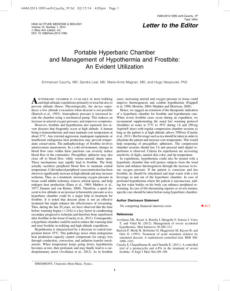

Authors: Jacek Kot
This paper aims to present current controversies
concerning the safety of medical devices and procedures
under pressure in a hyperbaric chamber, including:
defibrillation in a multiplace chamber; implantable devices
during hyperbaric oxygen treatment (HBOT), and the
results of a recent European questionnaire on medical
devices used inside hyperbaric chambers.



Authors:
Avi Shina, Erez Nissim Baruch, Amir Shlaifer, Ami Shovali,
Moran Levi, Or Yosefy, David Segal, Tarif Bader, Itai Shavit,
Avraham Yitzhak.
The authors examined the success rate and ease-of-use
ratings of an IO device, the NIO ® (New Intraosseous
Persys Medical, Houston, TX, USA) in comparison to the
Arrow ® EZ-IO ® (Teleflex Medical Research Triangle Park,
NC, USA) by novice users.



Authors:
Bistra Iordanova, Lingjue Li, Robert S. B. Clark, and Mioara
D. Manole.
Assessment of Cerebral Blood Flow (CBF) and
oxygenation is not routinely performed after cardiac arrest.
Limited clinical studies established the role of CBF and
oxygenation monitoring in prognostication after cardiac
arrest. Few studies suggest that guiding critical care post-
resuscitation to mean arterial pressures above the minimal
autoregulatory range might improve outcomes. Important
knowledge gaps thus remain in cerebral monitoring and
CBF and oxygen goal-directed therapies post-resuscitation
from cardiac arrest.



Authors:
Simon J Mitchell, Michael H Bennett, Phillip Bryson, Frank K
Butler, David J Doolette, James R Holm, Jacek Kot,
Pierre Lafère
Guidelines for the pre-hospital management of
decompression illness (DCI) had not been formally revised
since the 2004 Divers Alert network / Undersea and
Hyperbaric Medical Society workshop in Sydney, entitled
“Management of mild or marginal decompression illness
in remote locations”. The Diver’s Alert Network initiated a
recent review undertaken by an international committee
with members from Australasia, the USA, and Europe.



Publisher: Advanced Trauma Life Support (ATLS)
The American College of Surgeons (ACS) was founded to
improve the care of surgical patients, establishing and
maintaining a high quality of surgical practices.
In accordance with that role, the ACS Committee on
Trauma (COT) has worked to establish guidelines for the
care of injured patients.

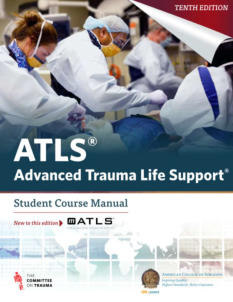

Authors:
Gilles Guerrier, Christine Agostini, Marion Antona, Fiorella
ponzini, Anne Paoletti, Isabelle Martin, Jean-Michel
Ekherian, Christophe Baillard.
I-gel® is a second generation supraglottic airway device
from Intersurgical and predsented in our website through
this link: https://diving-rov-specialists.com/medical-
equip.htm, and through this link:
https://www.intersurgical.com/
The optimal size of the I-Gel remains unclear since the
manufacturer's weight-based formula (size 3 for weight <
50 kg, size 4 for weight 50-90 kg, and size 5 for weight >
90 kg) for the laryngeal mask airway I-Gel is not evidence-
based. The authors hypothesized that sex might also guide
the choice of I-Gel size.



Authors:
Johanna Wall, Sriveena Naganathar, Banjerd
Praditsuktavorn, Oscar F. Bugg, Simon McArthur,
Christoph Thiemermann, Jordi L. Tremoleda, and Karim
Brohi.
Cardiac dysfunction (CD) significantly contributes to
mortality in trauma patients who survive their initial injuries
following successful hemostatic resuscitation. This poor
outcome has been correlated with elevated biomarkers of
myocardial injury, but the pathophysiology triggering this
cardiac dysfunction remains unknown. The authors
investigated the pathophysiology of acute Cardiac
dysfunction after trauma using a mouse model of trauma
hemorrhage shock (THS)-induced CD with
echocardiographic guidance of fluid resuscitation to assess
the THS impact on myocardial integrity and function.



Authors: Maritime & coast guard agency
Application of the Merchant Shipping and Fishing Vessels
(Medical Stores) Regulations 1995 (SI 1995/1802) and the
Merchant Shipping and Fishing Vessels (Medical Stores)
(Amendment) Regulations 1996 (SI 1996/2821)
Notice to all Shipowners, Agents, Masters, Skippers of
Fishing Vessels and all Seafarers



Authors: James Eric Neal, Brett Lewellyn
The primary purpose of this study was to compare
intraoperative and postoperative complication rates for
upper extremity surgical cases performed on a standard
operating room (OR) table with similar cases done on a
typical hospital stretcher. Secondary measures reviewed
included surgical time, turnover, total OR time, blood loss,
tourniquet time, and postoperative complications.



Authors:
Muhammad Husaini Rahmat, Ruhaizin S, Rosalam CM,
Hassan A, Khairul Manami K and Indastri S.
This study aims to determine efficient ways of lifting the
body based on rescuers' preferences. From the results,
new stretcher design parameters were established.



Authors:
Florian Ettl, Eva Fischer, Heidrun Losert, Dominik Stumpf ,
Robin Ristl, Kurt Ruetzler, Robert Greif, and Henrik Fischer
This study aimed to compare the cardiopulmonary
resuscitation (CPR) quality of an automated external
defibrillator (AED) with and without additional video
instruction during basic life support (BLS) by laypersons.



Authors:
Matteo Paganini, Giulia Mormando, Sandro Savino ,
Giacomo Garetto, Giulia Tiozzo, Enrico M. Camporesi ,
Fabrizio Fabris, and Gerardo Bosco.
Hyperbaric chambers and underwater environments are
challenging and at risk of serious accidents. Personnel
aiming to assist patients and subjects should be
appropriately trained, and several courses have been
established worldwide. In healthcare, simulation is an
effective learning technique. However, few peer-reviewed
articles have been published in the medical literature
describing its use in diving and hyperbaric medicine.




Authors:
Yu Liu, MD, Yanshu Zhang, Lei Zhang, Hongliang Bai, Gang
Wang, MD, Litao Guo
The purpose of this study was to analyze the role of SimMan
in resident training of emergency skills.
Fortyfive 1st year medical residents were selected for this
study. All participants were divided into groups and each
participant performed different roles during training. Clinical
cases were selected using the tutor mode/auto mode in
the SimMan computer system in order to train and assess
each group. A pre-test was administered to the 45 residents
before emergency medical technician (EMT) skill training.
Finally, a post-test was conducted with SimMan after
training. Tutors scored the student’s performance and
recorded the overall time for the procedure.



Authors: M Abdollahi, A Hosseini
This document describes the generation of H2S, its
mechanisms of toxicity, and the recommended treatment
procedures and precautions to be implemented at work.



Authors:
Jeroen Seesink, Stella Nieuwenburg, Theo van der Linden,
Joost J.L.M. Bierens
Little is known regarding the circumstances, outcomes,
and quality of operational lifeboat crews perform
cardiopulmonary resuscitation (CPR) and automated
external defibrillators (AEDs).
The authors aim to evaluate the circumstances, outcomes,
and quality of CPR performed by the Royal Dutch Lifeboat
Institution (KNRM) in out-of-hospital cardiac arrest (OHCA).




Authors:
Allart M. Venema, Marko M. Sahinovic, Albert J. D. W. R.
Ramaker, Yvette N. van de Riet, Anthony R. Absalom and J.
K. Götz Wietasch.
Crewmembers of the “Royal Netherlands Sea Rescue
Institution” (KNRM) lifeboats must wear heavy survival suits
with integrated lifejackets. This and the challenging
environment onboard (boat movements, limited space)
might influence Basic Life Support (BLS) performance. The
primary objective of this study was to assess the impact of
the protective gear on single-rescuer BLS-quality.



Authors: Malay Sarkar, Irappa Madabhavi, & Nagaveni
Kadakol
Oxygen is probably the most commonly prescribed drug
in the emergency setting and is a life-saving modality as
well. However, like any other drug, oxygen therapy may
also lead to various adverse effects. Patients with chronic
obstructive pulmonary disease (COPD) may develop
hypercapnia during supplemental oxygen therapy,
particularly if uncontrolled. The risk of hypercapnia is not
restricted to COPD only; it has also been reported in
patients with morbid obesity, asthma, cystic fibrosis, chest
wall skeletal deformities, bronchiectasis, chest wall
deformities, or neuromuscular disorders.



Authors: S. Nogue, R. Pou, J. Fernandez, and P. Sanz-
Fatal hydrogen sulphide poisoning usually occurs in
confined spaces. However, this report discusses two fatal
accidents in unconfined spaces. The first accident caused
the death of three workers who entered an unconfined
room in a silo of sludge at the same time that a truck
dumped several tons of sludge from water purification
stations. The hydrogen sulphide that had accumulated
inside the silo spilled out into the interior of the room due
to a ‘splashing effect’ caused by the impact of the dumped
sludge. The second accident occurred when the foreman
of a wastewater treatment plant entered one of the
substations to perform routine checks.



This Regulation aims to ensure the smooth functioning of
the internal market as regards medical devices, taking as a
base a high level of protection of health for patients and
users, and taking into account the small and medium-
sized enterprises that are active in this sector.
At the same time, this Regulation sets standards of quality
and safety for medical devices in order to meet common
safety concerns as regards such products.



Authors:
Surg Cdr Kamal Mishra, Surg Capt Gokul Krishnan
This document describes the effects of carbon monoxide
through historical examples. It also provides suggestions
for a better comprehension of the impact of this gas and
the methods to prevent them.



Author: N. K. I. McIver
This document provides an historic of the decompression
procedures since the observations of Robert Boyle to
today. This description includes the therapeutic
procedures.

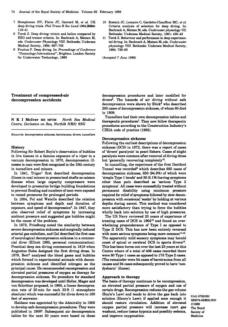

Publisher:
Undersea & Hyperbaric Medical Society
This document is a compilation of pratices made by UHMS
and published in April 2011. It is based in part on the USN
Diving Manual Revision 6; April 200 with Advance Change
Notices 15-102 , the Manual of the Medical Department
(ManMed) Change 126 - August 2005, the U.S. Air Force
Guidelines for Treating Altitude Decompression Sickness
(USAF Instruction 48-112), and Association of Diving
Contractors International (ADCI) Return to Diving
Guidelines after DCS - 2011.
Note that it could also be logged in “Diving & ROV
procedures” however the treatment side of the document
justifies to publish it in 1st aid.

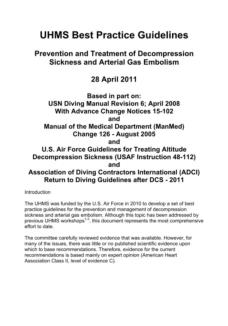

Authors: Richard E. Moon, Simon Mitchell
This document details procedures to implement for
treating decompression accidents. This document is not
specific to commercial diving.




Authors: Hiroki Nagasawa, Kazuhiko Omori, Kenichi
Muramatsu, Ikuto Takeuchi , Hiromichi
Ohsaka, Kouhei Ishikawa, and Youichi
Yanagawa
Traumatic cardiac arrest (TCA) is associated with poor
outcomes. Helicopter emergency medical services
(HEMSs) are often used to transport critically ill patients to
hospitals. However, the role of HEMS in the treatment of
TCA remains unclear. Therefore, in this study, we aimed to
determine the current status of patients with prehospital
TCA managed by HEMS personnel in Japan and compare
the outcomes of patients who experienced TCA before
and after the arrival of HEMS.





Click on the
octopus to return to
the top of the page




Author: Sara Booth, Heather Anderson, Maelie Swannick,
Rosemary Wade, Suzanne Kite, Miriam Johnson
This document intends to inform and provide
recommendations to clinicians working in palliative care
regarding the use of oxygen for the palliation of
breathlessness in patients with COPD, advanced cancer,
and chronic heart failure. It discusses the current state of
evidence, highlights the scarcity of randomized controlled
trials, and emphasizes the need for individualized
assessment of oxygen therapy's efficacy in reducing
breathlessness and improving quality of life.



Authors: Tony Alleman, & Joseph Serio
This document provides a detailed medical case report of
a commercial diver who developed a painful, swollen, and
infected thumb after sustaining a minor abrasion from a
barnacle while diving. It outlines the diver's initial
treatment with ciprofloxacin, the addition of doxycycline,
the progression of the infection, the surgical intervention
required, and the eventual identification of the infecting
organism as methicillin-resistant Staphylococcus aureus
(MRSA). It concludes with the successful treatment using
trimethoprim/sulfamethoxazole and rifampicin and the
diver's return to regular duty after recovery.



Authors: Ferhat Meziani , Xavier Delabranche, Pierre Asfar,
and Florence Toti
This paper provides a detailed explanation of the role of
microparticles in the pathophysiology of sepsis. It discusses
how microparticles, which are fragments originating from
the plasma membrane after cellular activation, contribute
to inflammation and coagulation processes in the body.
The text aims to highlight the significance of microparticles
in regulating vascular tone, acting as intercellular
messengers, and their potential involvement in the
mechanisms underlying multiple organ dysfunction in
septic shock.



This document's intent is to inform readers about the
purpose and process of the IARC Monographs series in
evaluating carcinogenic risks. It clarifies that the inclusion
of an agent in the Monographs does not necessarily
mean it is a carcinogen but rather that the available data
has been reviewed. It also encourages readers to provide
any new data that could affect the evaluation of an
agent's carcinogenic risk and to report any errors found in
the Monographs for correction in future volumes.



Authors: Adrian Fuente, Bradley McPherson, and Louise
Hickson
This study investigates the association between solvent
exposure and its adverse effects on both peripheral and
central auditory functioning. It aims to provide evidence of
solvent-induced hearing loss (SIHL) by using a
comprehensive audiological test battery and analyzing the
results through statistical models. Also, it seeks to discuss the
implications of these findings and the utility of specific
hearing tests in assessing SIHL.



Authors: Conkin J, Abercromby AFJ, Dervay JP, Feiveson
AH, Gernhardt ML, Norcross J, Ploutz-Snyder R,
Wessel JH
This document is a presentation that explains the
probabilistic nature of DCS symptoms and symptom
resolution, the tissue bubble dynamics model (TBDM), the
cumulative fraction of resolved symptoms with delta P and
the symptoms linked to this delta P, and hypobaric DCS
treatment models.




Authors: Surajit Bhattacharya, R. K. Mishra
This document comprehensively reviews pressure ulcers,
including their mechanism, symptoms, causes, severity,
diagnosis, prevention, and management. The article aims
to cover surgical and non-surgical treatment options,
focusing on current understandings and newer treatment
modalities. It also discusses the role of nutrition and
pressure-release devices in treating and preventing
pressure ulcers.
It must be noted that first aiders do not commonly
encounter this phenomenon due to the short time the
victims are under their responsibility. However, it could be
the case if, for various reasons, the victim is to be kept
some time on board.



This guidebook introduces the basic operations of the
Lucas chest compression system and provides guidelines
for conducting classroom and hands-on training
consistent with that provided by the manufacturer
(Stryker).



Authors: David Dayya, Owen J. O ’ Neil, Tracy D. Feiertag,
Ritzel Tuazon-Boer, John Sullivan, Lubiha Perez,
Sandrah Gurash, Matthew Eaton, Taylor Bodley,
Joanne Marker, Elizabeth Smykowski, T. Hall.
This study analyzes the effectiveness of using oxygen
hoods/helmets as a novel method of oxygen delivery for
COVID-19 patients to demonstrate that these devices can
improve oxygen saturation (SaO2), reduce the need for
mechanical ventilation (MV), lower mortality rates, and
shorten hospital stays for hypoxic COVID-19 patients who
do not respond well to conventional high-flow oxygen
delivery systems. The study provides statistical data from a
study comparing intervention and control groups to
support these claims.

Authors:
Abdelazeem M Algammal, Helal F Hetta, Amr Elkelish,
Dalal Hussien H Alkhalifah, Wael N Hozzein, Gaber El-
Saber Batiha, Nihal El Nahhas, Mahmoud A Mabrok
This document reviews Methicillin-resistant
Staphylococcus aureus (MRSA), focusing on its
significance as a pathogen in humans and animals. It
discusses various aspects of MRSA, including its impact on
public health and veterinary medicine, the diseases it
causes in different species, methods for detecting
methicillin resistance, and the prevalence of MRSA in
specific regions like Egypt.





Authors: Richard D. Vann & James Vorosmarti
This document comprehensively overviews the unique
challenges, training, and medical considerations
associated with military diving operations. It discusses the
various roles and responsibilities of military divers, their
training, and the specific medical support required due to
the physiological and environmental challenges of diving.
It also highlights the historical and operational context of
diving hazards and the therapy of diving casualties,
emphasizing the importance of specialized training for
military physicians in diving medicine.



Authors: B. Jüttner, C. Wölfel, H. Liedtke, K. Meyne, H.
Werr, T. Bräuer, M. Kemmerer, G. Schmeißer, T.
Piepho, O. Müller, H. Schöppenthau
This document introduces updated guidelines for diving
accidents published by the German Society for Diving and
Hyperbaric Medicine (GTÜM) and the Swiss Underwater
and Hyperbaric Medical Society (SUHMS). It details the
collaborative effort among various medical and diving
organizations to develop these guidelines, which provide
evidence-based instructions for first aid and medical
treatment of diving accidents. It also emphasizes the
importance of hyperbaric oxygen therapy (HBOT) and
suggests a nationwide register for quality management in
hyperbaric therapy.



Authors: Under the US Secretary of Defense for Personnel
and Readiness
This document provides detailed guidelines and
procedures for treating and managing decompression
sickness (DCS) using hyperbaric oxygen therapy. It outlines
specific protocols for oxygen administration,
decompression procedures, and emergency preparedness
in various scenarios related to diving and using a capsule
to ensure safety and effective treatment for divers
experiencing DCS. It emphasizes the importance of
maintaining proper oxygen levels and preparing
equipment for immediate use.





1 - Treatment of the diving casualty
Authors: D.H. Elliott, and R. de G. Hanson
Diving accidents are becoming more common in
hospitals due to the rise in both professional and amateur
diving. Many of these cases can be related to drowning
or hypothermia, but there are specific diving illnesses that
may also occur. Conditions like sub-arachnoid
hemorrhage or cardiac infarction can happen
underwater. This review will focus on diving-specific
conditions, excluding hypothermia and drowning. An
accurate diver history and details about the dives, like
equipment used and depth, are crucial for diagnosis.
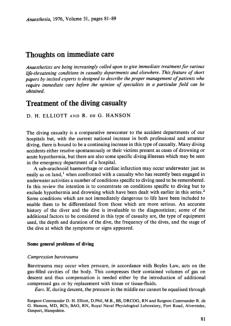


2 - Defibrillator Electrode-Chest Wall Coupling Agents: Influence on
Transthoracic Impedance and Shock Success.
Authors: Philip E Aylward, Robert Kieso, Pamela Hite,
Francis Charbonnier, Richard E. Kerber
This study aimed to find out if different coupling agents
affect the success of defibrillation shocks. Three agents
were tested on 10 anesthetized dogs with induced
ventricular fibrillation: Harco pads, Littman pads, and
Redux paste. Even though Redux paste had lower
impedance and higher current, there were no significant
differences in shock success among all three agents.
Therefore, disposable pads were as effective as electrode
paste for defibrillation.
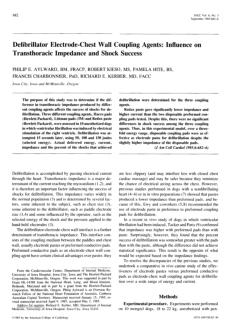



21 - A prospective, randomised trial of pneumothorax therapy:
Manual aspiration versus conventional chest tube drainage
Author: Mehmet Parlak, Steven M. Uil, Jan W.K. van den
Berg
No agreement exists on the treatment for pneumothorax
(PTX). Some guidelines suggest manual aspiration (MA)
might be better than tube thoracostomy (TT) for
uncomplicated primary spontaneous pneumothorax
(PSP). A trial with 56 patients showed MA had a lower
immediate success rate but resulted in shorter hospital
stays. Both methods had similar long-term outcomes.
Therefore, MA is recommended as the preferred
treatment.
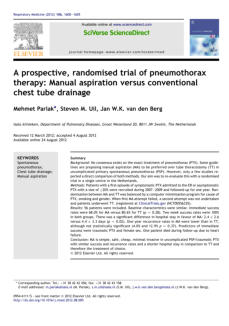



55 - Outpatient management of primary spontaneous
pneumothorax
Author:
Stephane Jouneau, Constance Vuillard, Alexandre Sale,
Yann Bazin, Laurent Sohier, Mallorie Kerjouan, Jean-
Damien Ricard, Jonathan Messika.
Spontaneous pneumothorax (SP) is classified as primary if
it occurs without known respiratory disease (PSP) and
secondary if linked to such diseases. Managing PSP aims
to fix the issue and reduce reoccurrence rates, which can
be high. Treatment often involves hospitalization and
chest-tube drainage, but some prefer outpatient care like
simple observation or needle aspiration. This review
focuses on safe outpatient management and necessary
interventions. It also discusses the reluctance of physicians
towards outpatient care due to legal concerns and
established practices.
